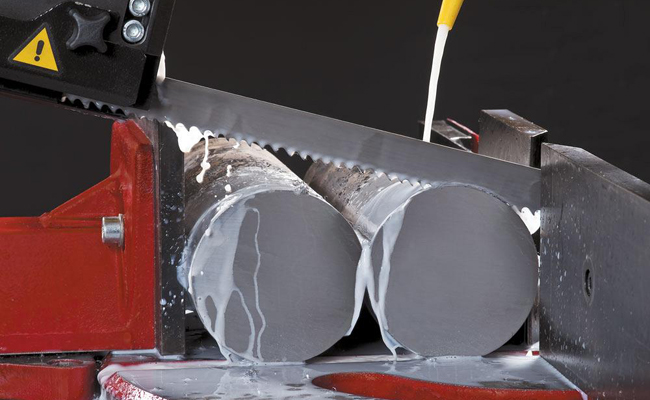BS-712N Belt Drive Bandsaw
Cutting Capacity :
During operation, metal band saw machines typically use cutting fluid, an industrial liquid designed to cool and lubricate the tool and workpiece. Composed of various high-performance additives scientifically blended, it provides excellent cooling, lubrication, rust prevention, degreasing and cleaning, anti-corrosion, and easy dilution properties.

1. Cleaning Effect
During cutting, the cutting fluid flushes away chips, grinding debris, iron powder, oil stains, and sand particles, preventing contamination of the saw machine, workpiece, and tool. This ensures the cutting edge remains sharp, maintaining cutting efficiency.
Oil-based cutting fluids with lower viscosity have stronger cleaning capabilities, especially those containing kerosene or diesel, which offer excellent permeability and cleaning performance.
Water-based cutting fluids containing surfactants provide superior cleaning by forming an adsorption film on surfaces, preventing particles and sludge from sticking to the workpiece, tool, or grinding wheel. The fluid penetrates the interface between contaminants and the surface, separating and carrying them away to keep the cutting fluid clean.
2. Rust Prevention
During cutting, workpieces are exposed to environmental factors and corrosive byproducts (such as decomposed or oxidized cutting fluid residues), which can cause corrosion. Similarly, machine components in contact with the cutting fluid may also corrode.
Additionally, workpieces may need temporary storage between processes, requiring the cutting fluid to provide rust prevention to protect against environmental and residual corrosive substances.
3. Cooling Effect
The cutting fluid absorbs and dissipates heat from the cutting tool (or grinding wheel), chips, and workpiece through convection and vaporization. This effectively reduces cutting temperatures, minimizing thermal deformation in the workpiece and tool while maintaining tool hardness.
Key factors: Thermal conductivity, specific heat capacity, heat of vaporization, and viscosity of the cutting fluid influence cooling efficiency.
Benefits: Improved machining accuracy and extended tool life.
4. Lubrication Effect
The lubricating properties of cutting fluids reduce friction between the tool’s rake face and chips, as well as between the flank face and the machined surface. A lubricating film forms, decreasing cutting forces, friction, and power consumption.
Tool wear reduction: Lower friction reduces tool wear and heat generation.
Grinding applications: In grinding, the cutting fluid penetrates between the grinding wheel, workpiece, and chips, forming a lubricating film that minimizes abrasive wear and prevents chip adhesion. This enhances wheel durability and workpiece surface quality.
Cutting fluid is essential in metal band saw operations for:
Cleaning (removing debris and contaminants)
Rust prevention (protecting workpieces and machinery)
Cooling (reducing heat and thermal distortion)
Lubrication (reducing friction and tool wear)
The right cutting fluid selection (water-based for cooling, oil-based for lubrication) optimizes machining efficiency, tool life, and workpiece quality while ensuring environmental and operator safety.
Cutting Capacity :
Cutting Capacity :